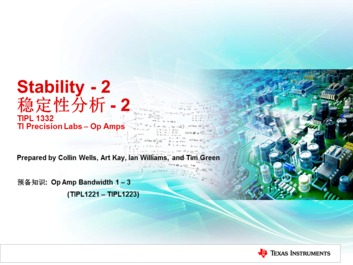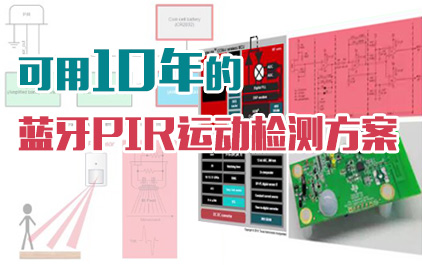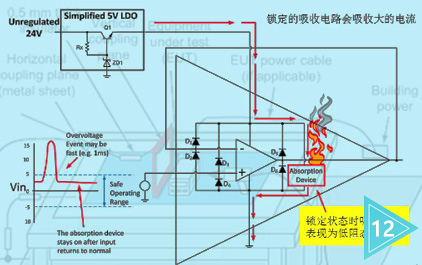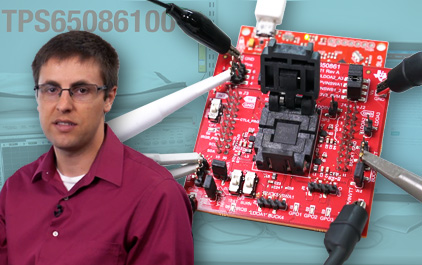2.2 DLP技术在高分辨率前照灯应用中的优势
Loading the player...
将在30s后自动为您播放下一课程
In this TI DLP Labs video, we will describe some key advantages of using DLP technology for high-resolution headlight applications and describe some typical use cases. DLP technology enables incredibly high-resolution headlight modules. The automotive-qualified DLP5531-Q1 DMD, or Digital Micromirror Device, has over 1 million pixels. And there's no sacrifice to style when the final lens height of a DLP5531-Q1 headlight module can remain under 40 millimeters. A headlight module that uses DLP technology can be designed with LED or laser illumination. DLP technology has been proven over 20 years in markets such as cinema and enterprise projection, and now it's automotive-qualified and in production vehicles today. What can a headlight do with 1 million pixels? One application is Adaptive Driving Beam, or ADB. ADB allows the high beam to remain on continuously while shaping light around oncoming traffic. DLP technology's high-resolution allows precise illumination control, put light exactly where it is needed so more of the high beam can remain on at all times without blinding oncoming traffic or pedestrians. More light can show drivers and ADAS systems everything in view, giving them more time to react to changes if needed. High resolution can also create smooth, gradient transitions in the light shape to avoid rapid, jerking motion of light that can be seen in low-resolution ADB options. Use the full programmability of high-resolution headlights to reinvent how vehicles and drivers see at night. Highly reflective road signs can glare drivers and oversaturate camera sensors. With high-resolution DLP technology, the headlight can dim or turn off pixels to avoid glare for the driver or camera while highlighting pedestrians, cyclists, and obstacles to give the driver and ADAS systems time to react. And ADB is only the beginning of what a high-resolution headlight can do. Any custom content can be displayed on the road. This enables a new communication channel between the vehicle and the driver. Here, the headlights are used to project lines indicating a vehicle path and to show the vehicle width as it traverses a narrow construction zone. Lane marking can give drivers and also other cars more confidence to safely navigate through hazards by communicating intent. Only the highest resolution makes symbol projection possible. Symbol projection enables welcome messages to the driver, differentiated branding, navigation, warnings, and other vehicle-to-everything, or V2X, communication to be conveyed on the road. Here, an arrow and distance are projected onto the road to indicate where a turn is located. But how many pixels does a headlight really need to perform these functions? To answer that, let's look at the navigation symbol that was projected on the previous slide. We can assume the headlight is mounted in the vehicle approximately 60 centimeters above the road. The symbol is 2 meters long and projected at a distance of 10 meters. Because of the steep angle that this symbol is projected on the ground, it actually fills less than 1 degree of the headlights' entire field of view. These images show the flattened image from the headlights' perspective. In a typical design, the DLP5531-Q1 DMD is able to use 50 to 100 lines of pixels to display this symbol due to its high pixels per degree, depending on the optical design. Other so-called high-resolution headlight technologies struggle with too few pixels for this level of detail. Click the links on this slide or immediately below this video to learn more about DLP technology in high-resolution headlights. Our white paper, Trends in High-Resolution Headlamps, provides more detail on headlight field of view and resolution. For more information, visit TI.com/DLP. Thanks for watching.
In this TI DLP Labs video, we will describe some key advantages of using DLP technology for high-resolution headlight applications and describe some typical use cases. DLP technology enables incredibly high-resolution headlight modules. The automotive-qualified DLP5531-Q1 DMD, or Digital Micromirror Device, has over 1 million pixels. And there's no sacrifice to style when the final lens height of a DLP5531-Q1 headlight module can remain under 40 millimeters. A headlight module that uses DLP technology can be designed with LED or laser illumination. DLP technology has been proven over 20 years in markets such as cinema and enterprise projection, and now it's automotive-qualified and in production vehicles today. What can a headlight do with 1 million pixels? One application is Adaptive Driving Beam, or ADB. ADB allows the high beam to remain on continuously while shaping light around oncoming traffic. DLP technology's high-resolution allows precise illumination control, put light exactly where it is needed so more of the high beam can remain on at all times without blinding oncoming traffic or pedestrians. More light can show drivers and ADAS systems everything in view, giving them more time to react to changes if needed. High resolution can also create smooth, gradient transitions in the light shape to avoid rapid, jerking motion of light that can be seen in low-resolution ADB options. Use the full programmability of high-resolution headlights to reinvent how vehicles and drivers see at night. Highly reflective road signs can glare drivers and oversaturate camera sensors. With high-resolution DLP technology, the headlight can dim or turn off pixels to avoid glare for the driver or camera while highlighting pedestrians, cyclists, and obstacles to give the driver and ADAS systems time to react. And ADB is only the beginning of what a high-resolution headlight can do. Any custom content can be displayed on the road. This enables a new communication channel between the vehicle and the driver. Here, the headlights are used to project lines indicating a vehicle path and to show the vehicle width as it traverses a narrow construction zone. Lane marking can give drivers and also other cars more confidence to safely navigate through hazards by communicating intent. Only the highest resolution makes symbol projection possible. Symbol projection enables welcome messages to the driver, differentiated branding, navigation, warnings, and other vehicle-to-everything, or V2X, communication to be conveyed on the road. Here, an arrow and distance are projected onto the road to indicate where a turn is located. But how many pixels does a headlight really need to perform these functions? To answer that, let's look at the navigation symbol that was projected on the previous slide. We can assume the headlight is mounted in the vehicle approximately 60 centimeters above the road. The symbol is 2 meters long and projected at a distance of 10 meters. Because of the steep angle that this symbol is projected on the ground, it actually fills less than 1 degree of the headlights' entire field of view. These images show the flattened image from the headlights' perspective. In a typical design, the DLP5531-Q1 DMD is able to use 50 to 100 lines of pixels to display this symbol due to its high pixels per degree, depending on the optical design. Other so-called high-resolution headlight technologies struggle with too few pixels for this level of detail. Click the links on this slide or immediately below this video to learn more about DLP technology in high-resolution headlights. Our white paper, Trends in High-Resolution Headlamps, provides more detail on headlight field of view and resolution. For more information, visit TI.com/DLP. Thanks for watching.
In this TI DLP Labs video, we will
describe some key advantages of using DLP technology
for high-resolution headlight applications
and describe some typical use cases.
DLP technology enables incredibly high-resolution
headlight modules.
The automotive-qualified DLP5531-Q1 DMD,
or Digital Micromirror Device, has over 1 million pixels.
And there's no sacrifice to style
when the final lens height of a DLP5531-Q1 headlight module
can remain under 40 millimeters.
A headlight module that uses DLP technology
can be designed with LED or laser illumination.
DLP technology has been proven over 20 years in markets
such as cinema and enterprise projection,
and now it's automotive-qualified
and in production vehicles today.
What can a headlight do with 1 million pixels?
One application is Adaptive Driving Beam, or ADB.
ADB allows the high beam to remain on continuously
while shaping light around oncoming traffic.
DLP technology's high-resolution allows
precise illumination control, put light
exactly where it is needed so more of the high beam
can remain on at all times without blinding oncoming
traffic or pedestrians.
More light can show drivers and ADAS systems everything
in view, giving them more time to react to changes if needed.
High resolution can also create smooth, gradient transitions
in the light shape to avoid rapid, jerking motion of light
that can be seen in low-resolution ADB options.
Use the full programmability of high-resolution headlights
to reinvent how vehicles and drivers see at night.
Highly reflective road signs can glare drivers and oversaturate
camera sensors.
With high-resolution DLP technology,
the headlight can dim or turn off
pixels to avoid glare for the driver or camera
while highlighting pedestrians, cyclists,
and obstacles to give the driver and ADAS systems time to react.
And ADB is only the beginning of what
a high-resolution headlight can do.
Any custom content can be displayed on the road.
This enables a new communication channel between the vehicle
and the driver.
Here, the headlights are used to project lines indicating
a vehicle path and to show the vehicle width as it traverses
a narrow construction zone.
Lane marking can give drivers and also other cars
more confidence to safely navigate through hazards
by communicating intent.
Only the highest resolution makes symbol projection
possible.
Symbol projection enables welcome messages
to the driver, differentiated branding, navigation, warnings,
and other vehicle-to-everything, or V2X, communication
to be conveyed on the road.
Here, an arrow and distance are projected onto the road
to indicate where a turn is located.
But how many pixels does a headlight really need
to perform these functions?
To answer that, let's look at the navigation symbol
that was projected on the previous slide.
We can assume the headlight is mounted in the vehicle
approximately 60 centimeters above the road.
The symbol is 2 meters long and projected
at a distance of 10 meters.
Because of the steep angle that this symbol is projected
on the ground, it actually fills less than 1 degree
of the headlights' entire field of view.
These images show the flattened image
from the headlights' perspective.
In a typical design, the DLP5531-Q1 DMD
is able to use 50 to 100 lines of pixels
to display this symbol due to its high pixels per degree,
depending on the optical design.
Other so-called high-resolution headlight technologies
struggle with too few pixels for this level of detail.
Click the links on this slide or immediately below this video
to learn more about DLP technology
in high-resolution headlights.
Our white paper, Trends in High-Resolution Headlamps,
provides more detail on headlight field
of view and resolution.
For more information, visit TI.com/DLP.
Thanks for watching.
In this TI DLP Labs video, we will describe some key advantages of using DLP technology for high-resolution headlight applications and describe some typical use cases. DLP technology enables incredibly high-resolution headlight modules. The automotive-qualified DLP5531-Q1 DMD, or Digital Micromirror Device, has over 1 million pixels. And there's no sacrifice to style when the final lens height of a DLP5531-Q1 headlight module can remain under 40 millimeters. A headlight module that uses DLP technology can be designed with LED or laser illumination. DLP technology has been proven over 20 years in markets such as cinema and enterprise projection, and now it's automotive-qualified and in production vehicles today. What can a headlight do with 1 million pixels? One application is Adaptive Driving Beam, or ADB. ADB allows the high beam to remain on continuously while shaping light around oncoming traffic. DLP technology's high-resolution allows precise illumination control, put light exactly where it is needed so more of the high beam can remain on at all times without blinding oncoming traffic or pedestrians. More light can show drivers and ADAS systems everything in view, giving them more time to react to changes if needed. High resolution can also create smooth, gradient transitions in the light shape to avoid rapid, jerking motion of light that can be seen in low-resolution ADB options. Use the full programmability of high-resolution headlights to reinvent how vehicles and drivers see at night. Highly reflective road signs can glare drivers and oversaturate camera sensors. With high-resolution DLP technology, the headlight can dim or turn off pixels to avoid glare for the driver or camera while highlighting pedestrians, cyclists, and obstacles to give the driver and ADAS systems time to react. And ADB is only the beginning of what a high-resolution headlight can do. Any custom content can be displayed on the road. This enables a new communication channel between the vehicle and the driver. Here, the headlights are used to project lines indicating a vehicle path and to show the vehicle width as it traverses a narrow construction zone. Lane marking can give drivers and also other cars more confidence to safely navigate through hazards by communicating intent. Only the highest resolution makes symbol projection possible. Symbol projection enables welcome messages to the driver, differentiated branding, navigation, warnings, and other vehicle-to-everything, or V2X, communication to be conveyed on the road. Here, an arrow and distance are projected onto the road to indicate where a turn is located. But how many pixels does a headlight really need to perform these functions? To answer that, let's look at the navigation symbol that was projected on the previous slide. We can assume the headlight is mounted in the vehicle approximately 60 centimeters above the road. The symbol is 2 meters long and projected at a distance of 10 meters. Because of the steep angle that this symbol is projected on the ground, it actually fills less than 1 degree of the headlights' entire field of view. These images show the flattened image from the headlights' perspective. In a typical design, the DLP5531-Q1 DMD is able to use 50 to 100 lines of pixels to display this symbol due to its high pixels per degree, depending on the optical design. Other so-called high-resolution headlight technologies struggle with too few pixels for this level of detail. Click the links on this slide or immediately below this video to learn more about DLP technology in high-resolution headlights. Our white paper, Trends in High-Resolution Headlamps, provides more detail on headlight field of view and resolution. For more information, visit TI.com/DLP. Thanks for watching.
In this TI DLP Labs video, we will
describe some key advantages of using DLP technology
for high-resolution headlight applications
and describe some typical use cases.
DLP technology enables incredibly high-resolution
headlight modules.
The automotive-qualified DLP5531-Q1 DMD,
or Digital Micromirror Device, has over 1 million pixels.
And there's no sacrifice to style
when the final lens height of a DLP5531-Q1 headlight module
can remain under 40 millimeters.
A headlight module that uses DLP technology
can be designed with LED or laser illumination.
DLP technology has been proven over 20 years in markets
such as cinema and enterprise projection,
and now it's automotive-qualified
and in production vehicles today.
What can a headlight do with 1 million pixels?
One application is Adaptive Driving Beam, or ADB.
ADB allows the high beam to remain on continuously
while shaping light around oncoming traffic.
DLP technology's high-resolution allows
precise illumination control, put light
exactly where it is needed so more of the high beam
can remain on at all times without blinding oncoming
traffic or pedestrians.
More light can show drivers and ADAS systems everything
in view, giving them more time to react to changes if needed.
High resolution can also create smooth, gradient transitions
in the light shape to avoid rapid, jerking motion of light
that can be seen in low-resolution ADB options.
Use the full programmability of high-resolution headlights
to reinvent how vehicles and drivers see at night.
Highly reflective road signs can glare drivers and oversaturate
camera sensors.
With high-resolution DLP technology,
the headlight can dim or turn off
pixels to avoid glare for the driver or camera
while highlighting pedestrians, cyclists,
and obstacles to give the driver and ADAS systems time to react.
And ADB is only the beginning of what
a high-resolution headlight can do.
Any custom content can be displayed on the road.
This enables a new communication channel between the vehicle
and the driver.
Here, the headlights are used to project lines indicating
a vehicle path and to show the vehicle width as it traverses
a narrow construction zone.
Lane marking can give drivers and also other cars
more confidence to safely navigate through hazards
by communicating intent.
Only the highest resolution makes symbol projection
possible.
Symbol projection enables welcome messages
to the driver, differentiated branding, navigation, warnings,
and other vehicle-to-everything, or V2X, communication
to be conveyed on the road.
Here, an arrow and distance are projected onto the road
to indicate where a turn is located.
But how many pixels does a headlight really need
to perform these functions?
To answer that, let's look at the navigation symbol
that was projected on the previous slide.
We can assume the headlight is mounted in the vehicle
approximately 60 centimeters above the road.
The symbol is 2 meters long and projected
at a distance of 10 meters.
Because of the steep angle that this symbol is projected
on the ground, it actually fills less than 1 degree
of the headlights' entire field of view.
These images show the flattened image
from the headlights' perspective.
In a typical design, the DLP5531-Q1 DMD
is able to use 50 to 100 lines of pixels
to display this symbol due to its high pixels per degree,
depending on the optical design.
Other so-called high-resolution headlight technologies
struggle with too few pixels for this level of detail.
Click the links on this slide or immediately below this video
to learn more about DLP technology
in high-resolution headlights.
Our white paper, Trends in High-Resolution Headlamps,
provides more detail on headlight field
of view and resolution.
For more information, visit TI.com/DLP.
Thanks for watching.
手机看
扫码用手机观看
 视频简介
视频简介
2.2 DLP技术在高分辨率前照灯应用中的优势
所属课程:TI DLP® Labs - 汽车
发布时间:2019.12.11
视频集数:18
本节视频时长:00:04:27
了解有关在自适应驱动光束前照灯技术中使用一百万个可寻址像素的优势。主要内容包括镜头高度要求、提高对驾驶员和ADAS系统的照明能力、车道标记、符号投影、车对车通信、人车沟通和车联万物(V2X)通信。
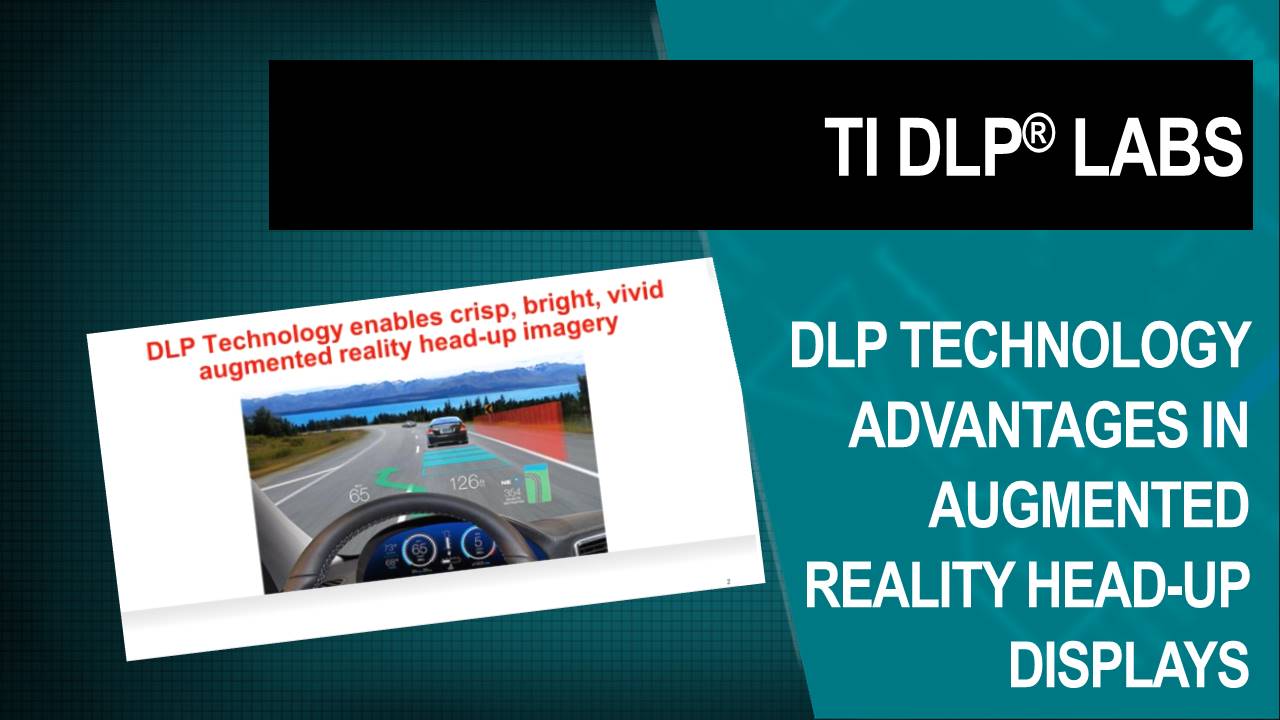 未学习 1.1 DLP技术在增强现实抬头显示器应用中的优势
未学习 1.1 DLP技术在增强现实抬头显示器应用中的优势
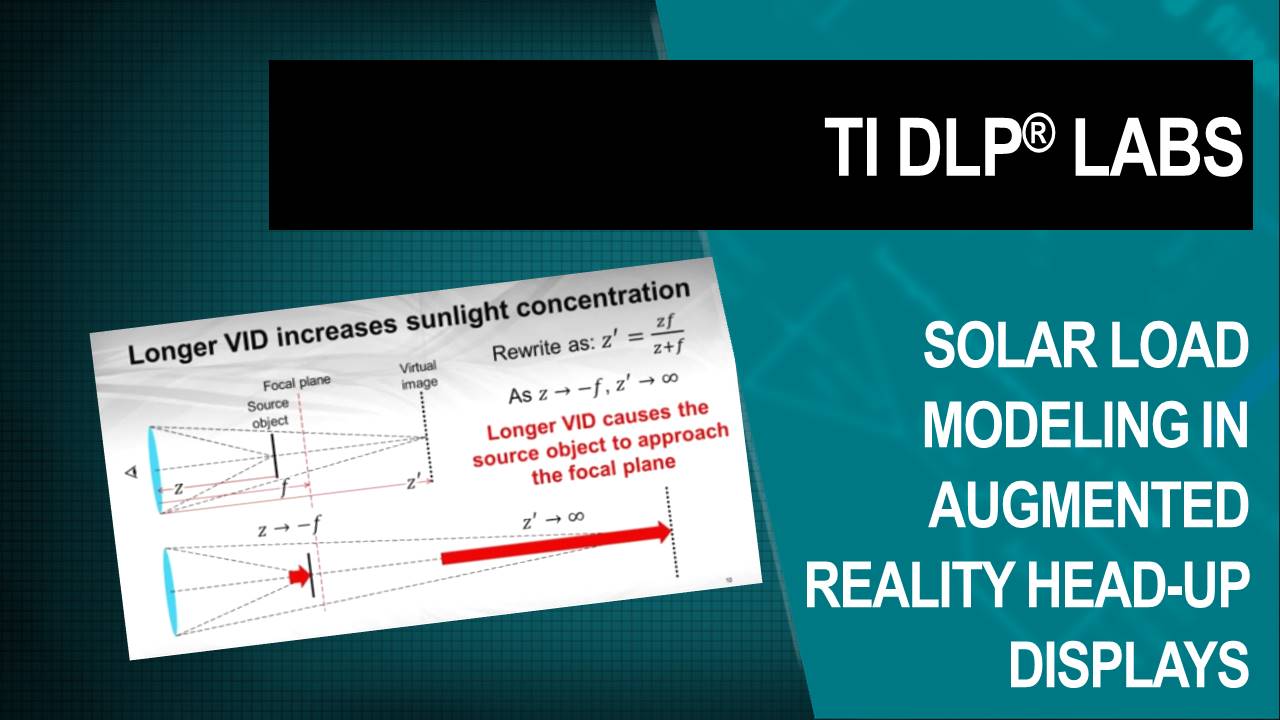 未学习 1.2 太阳能负载建模在增强现实抬头显示器设计中的重要性
未学习 1.2 太阳能负载建模在增强现实抬头显示器设计中的重要性
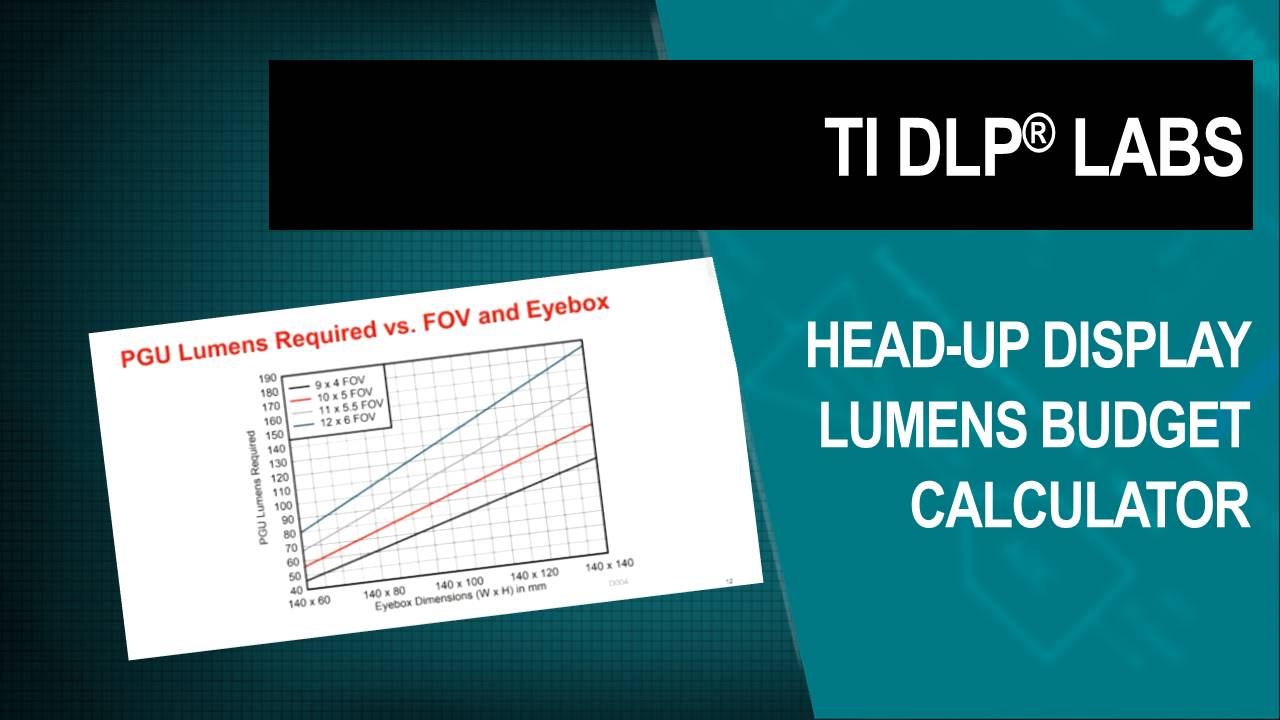 未学习 1.3 抬头显示器流明预算估算计算器
未学习 1.3 抬头显示器流明预算估算计算器
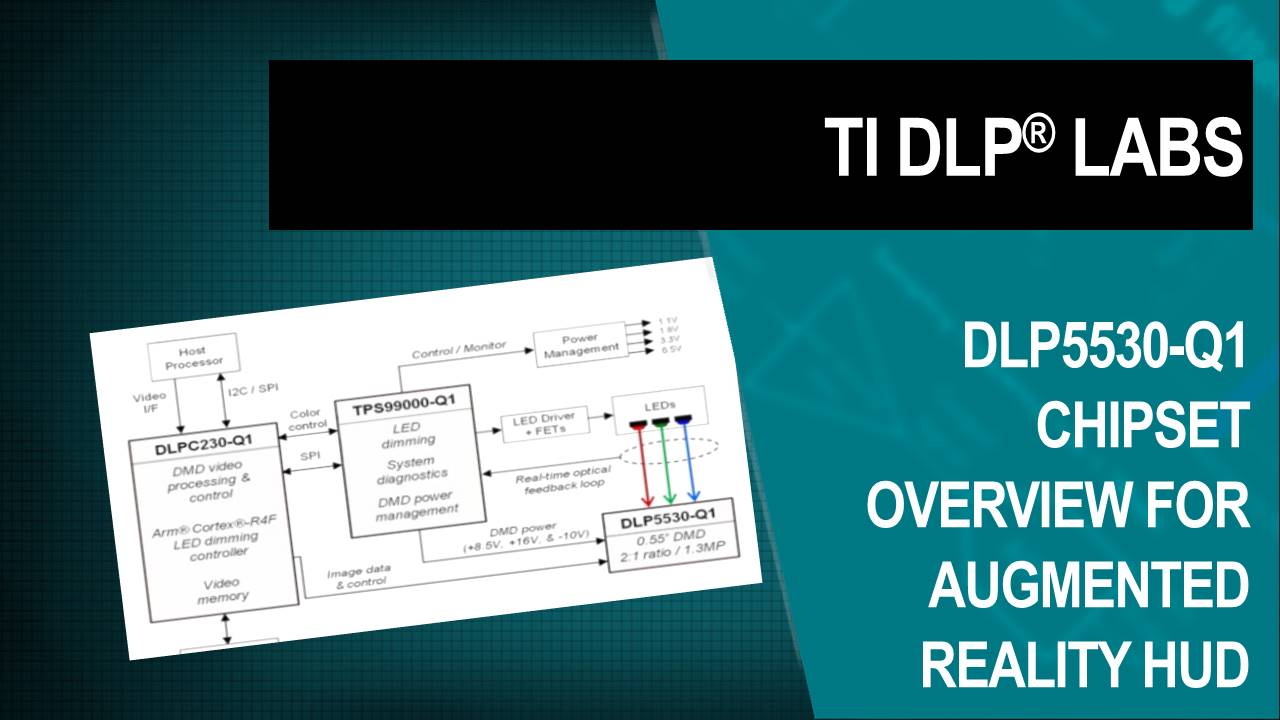 未学习 1.4 DLP® 产品:用于增强现实HUD的DLP5530-Q1芯片组介绍
未学习 1.4 DLP® 产品:用于增强现实HUD的DLP5530-Q1芯片组介绍
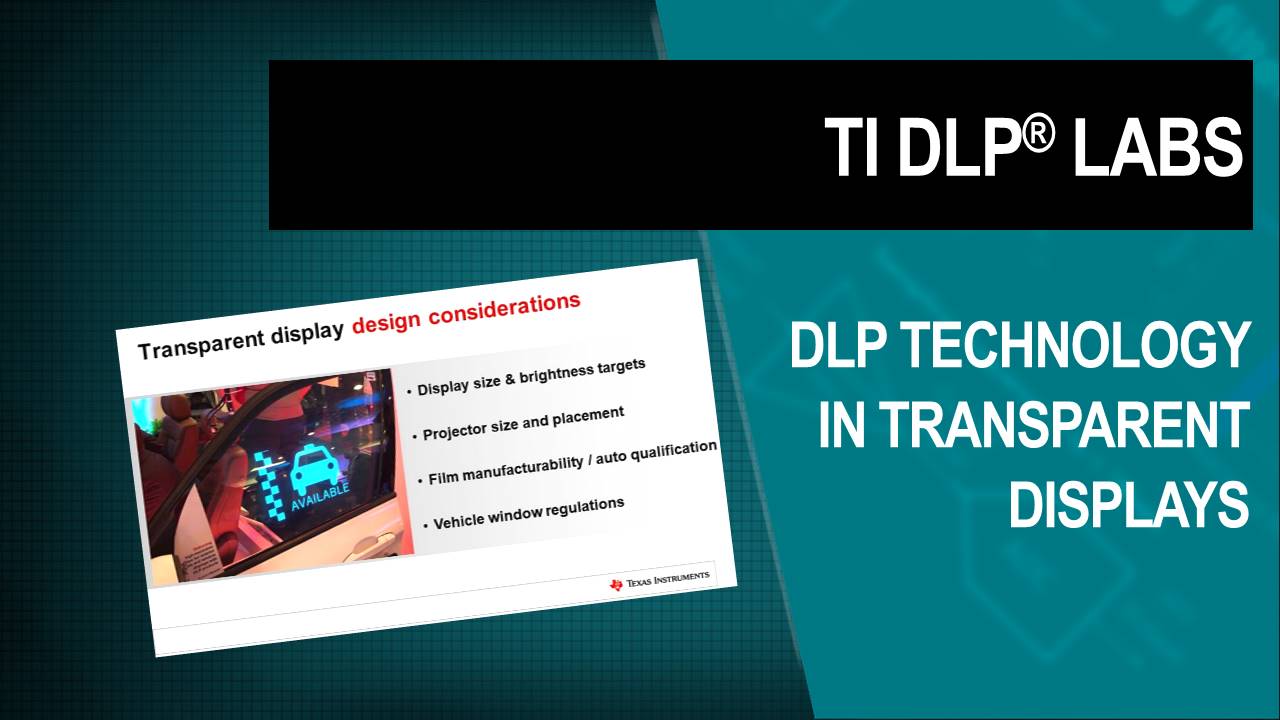 未学习 1.5 DLP技术在透明显示器中的应用
未学习 1.5 DLP技术在透明显示器中的应用
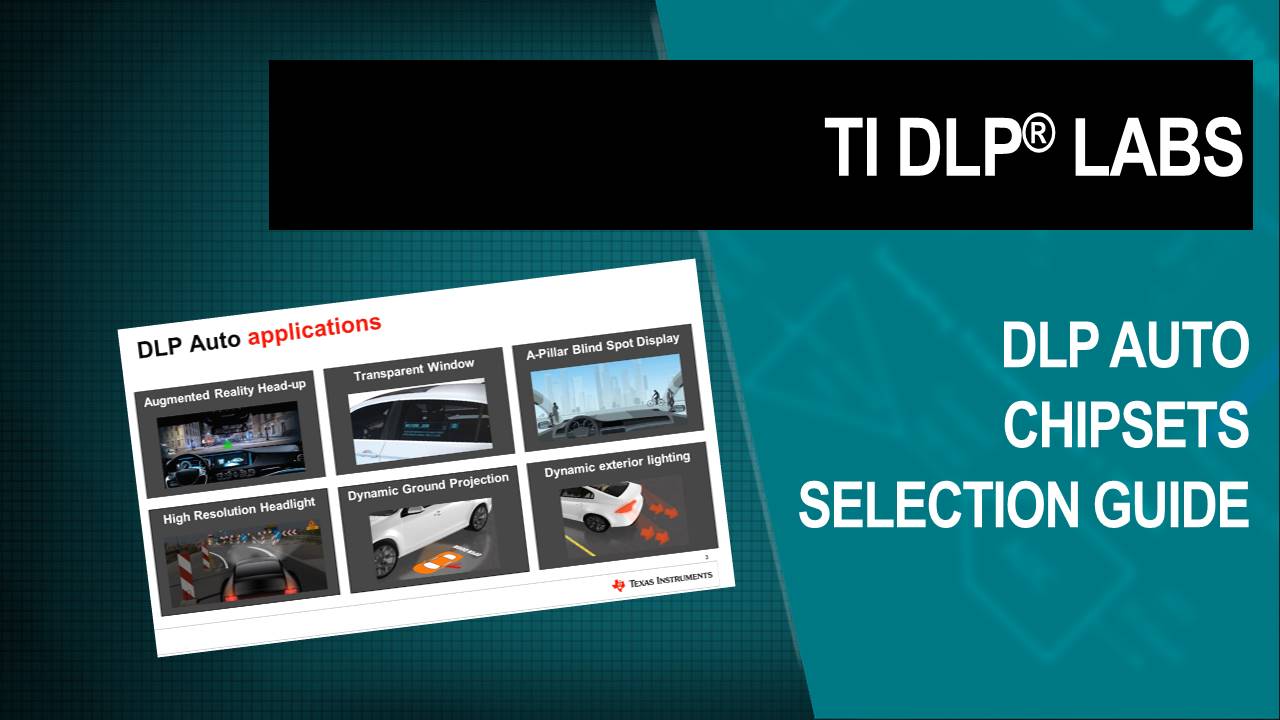 未学习 1.6 DLP Auto芯片组选择指南
未学习 1.6 DLP Auto芯片组选择指南
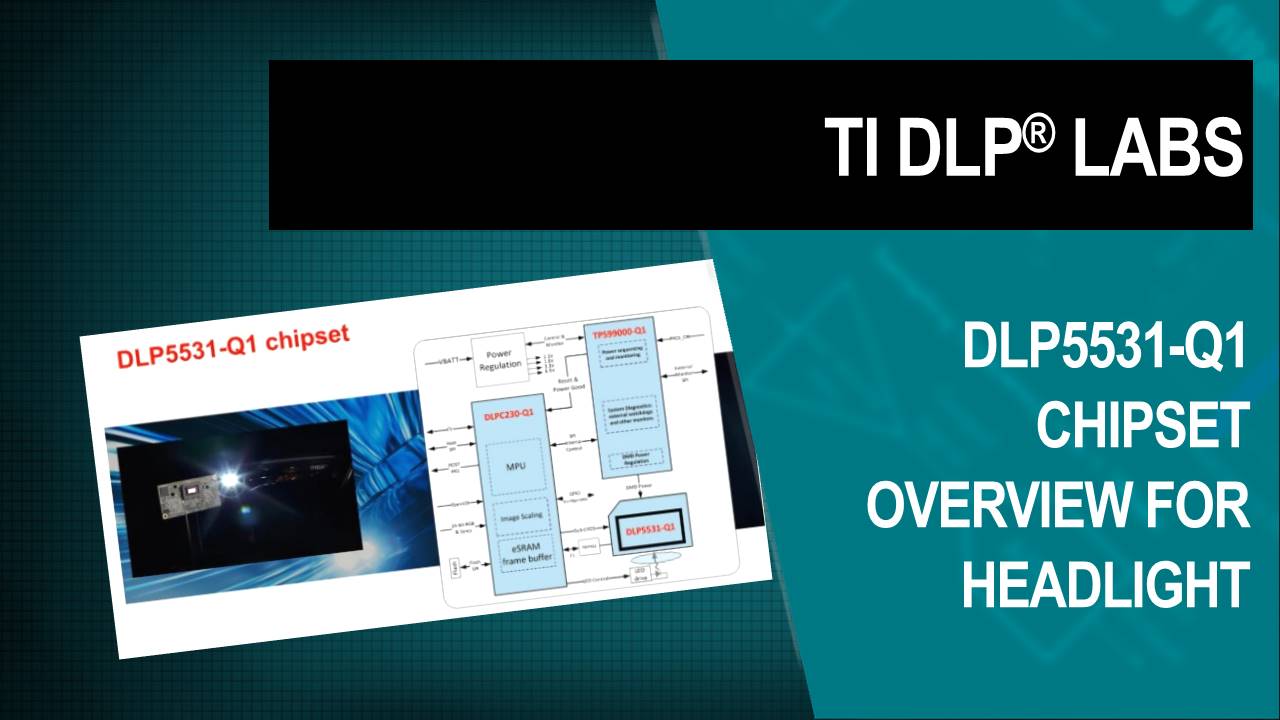 未学习 2.1 DLP5531-Q1前照灯芯片组
未学习 2.1 DLP5531-Q1前照灯芯片组
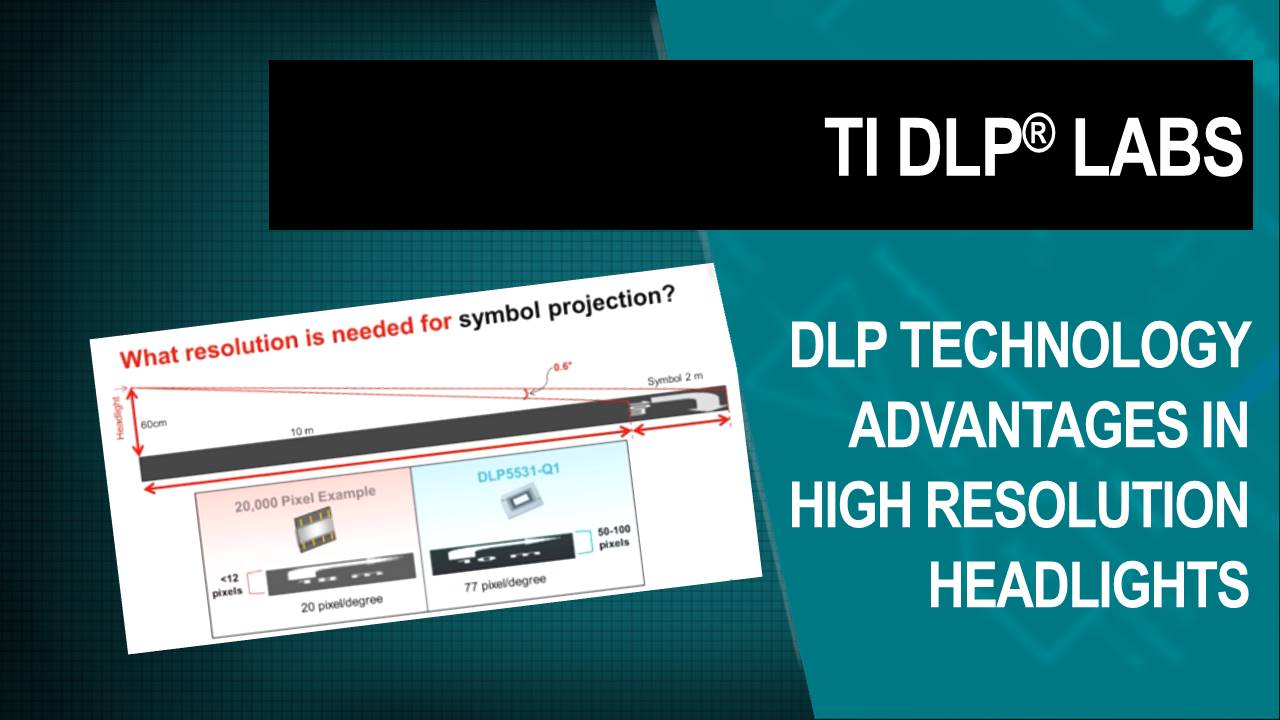 未学习 2.2 DLP技术在高分辨率前照灯应用中的优势
未学习 2.2 DLP技术在高分辨率前照灯应用中的优势
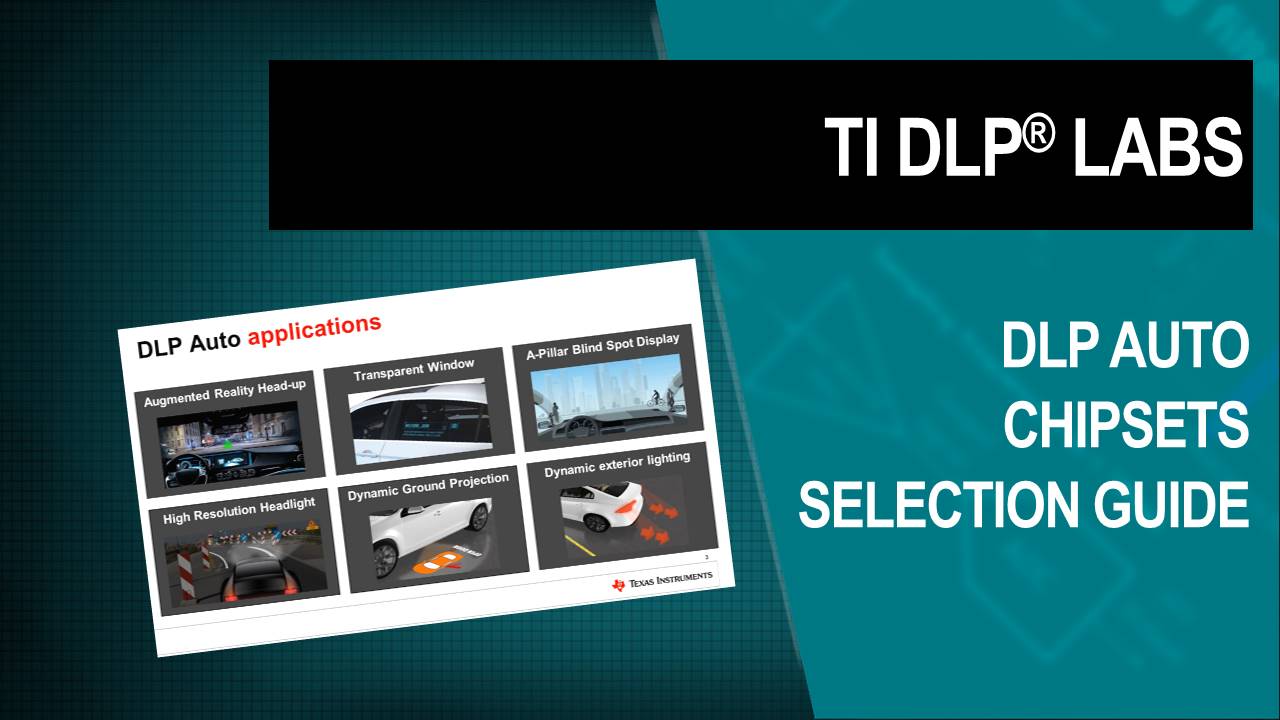 未学习 2.3 DLP Auto芯片组选择指南
未学习 2.3 DLP Auto芯片组选择指南
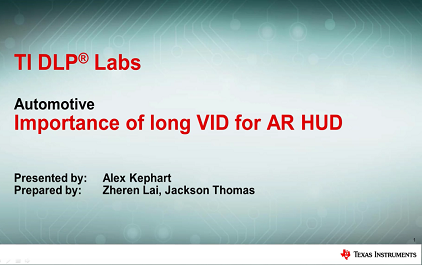 未学习 长虚像距离对汽车AR HUD应用的重要性
未学习 长虚像距离对汽车AR HUD应用的重要性
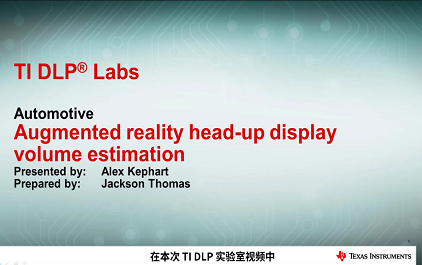 未学习 增强现实平视显示器体积估算
未学习 增强现实平视显示器体积估算
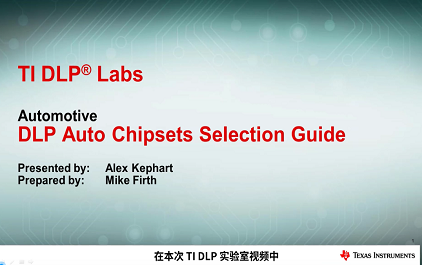 未学习 DLP 汽车芯片组选型指南
未学习 DLP 汽车芯片组选型指南
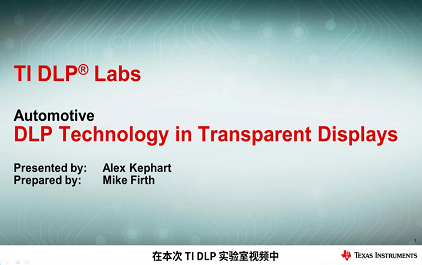 未学习 透明显示中的DLP技术
未学习 透明显示中的DLP技术
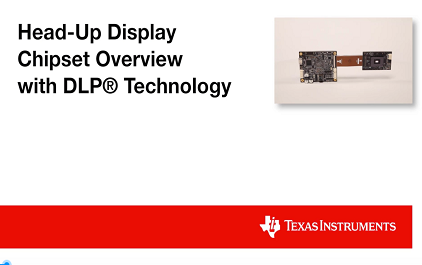 未学习 DLP3030-Q1 芯片组概述
未学习 DLP3030-Q1 芯片组概述
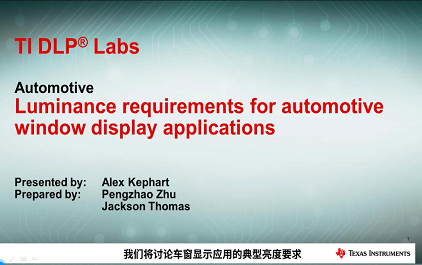 未学习 汽车橱窗显示应用的亮度要求
未学习 汽车橱窗显示应用的亮度要求
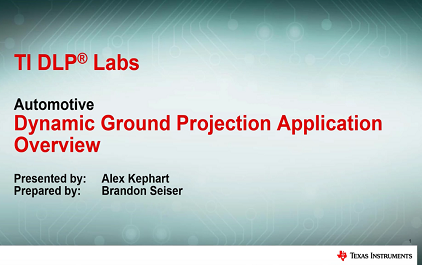 未学习 汽车动态地面投影应用概述
未学习 汽车动态地面投影应用概述
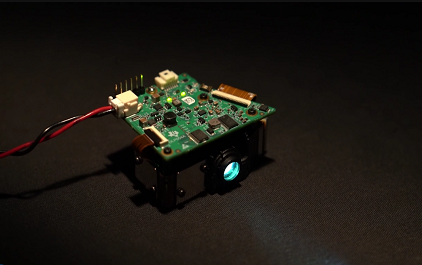 未学习 DLP3021LEQ1EVM 入门 - 硬件
未学习 DLP3021LEQ1EVM 入门 - 硬件
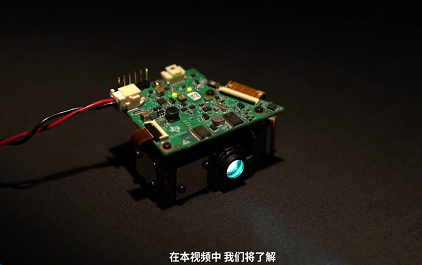 未学习 DLP3021LEQ1EVM 入门 - 软件
未学习 DLP3021LEQ1EVM 入门 - 软件



